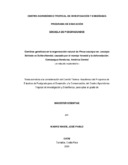| dc.contributor.advisor | Cornelius, Jonathan | |
| dc.contributor.author | Madríz Masís, José P. | |
| dc.date.accessioned | 2014-10-20T05:06:48Z | |
| dc.date.available | 2014-10-20T05:06:48Z | |
| dc.date.issued | 2005 | es_ES |
| dc.identifier.uri | https://repositorio.catie.ac.cr/handle/11554/5168 | |
| dc.description | Tesis (Mag. Sc) -- CATIE, Turrialba (Costa Rica), 2005 | es_ES |
| dc.description.abstract | Pinus oocarpa var. oocarpa Schiede ex Schlechtendal es la conífera con mayor distribución natural en el neotrópico, es predominantemente alógama de polinización mediada por el viento. Para las coníferas existe evidencia consistente de que el aislamiento por distancia aumentan las tasas de autofertilización, y la consecuente depresión por endogamia. En la unidad de Manejo Forestal Lajas (Comayagua, Honduras) se analizaron tres rodales, los resultados se presentan en el sentido en que la densidad demográfica se reduce, en árboles/ha: R3 = 190, R2 = 102 (rodales continuos) y R1 = 7 (potrero arbolado). Las hipótesis se plantearon para demostrar que la reducción demográfica, y el consecuente aislamiento por distancia incrementa la tasa de endogamia natural, para esto se utilizaron marcadores morfológicos ampliamente reportados en la literatura para otras especies de pinos. Nosotros concluimos que el aislamiento por distancia causado por el manejo forestal y la deforestación, incrementó la auto-fertilización y por lo tanto la depresión por endogama. | es_ES |
| dc.description.abstract | Pinus oocarpa var. oocarpa Schiede ex- Schlechtendal is the conifer with greater natural distribution in the neotropics, is predominantly outcrossing with wind pollination. There is evidence in conifers that isolation by distance increases the rates of self-fertilization, and the consequent depression by inbreeding. In the Unit of Forest Management Lajas (Comayagua, Honduras) three stands were analyzed, the results showed that the demographic density is reduced, in trees/ha: R3 = 190, R2 = 102 (continuous stands and R1 = 7 (grassland with trees). The hypotheses were elaborated to demonstrate that the demographic reduction, and the consequent isolation by distance it increases the natural selfing rate for this morphologic markers were used, these have been widely reported for others pine species. We concluded that the isolation by distance caused by the forest management and the deforestation, increases the self-fertilization and therefore the depression by inbreeding. | |
| dc.format.extent | 235 páginas | |
| dc.language.iso | es | es_ES |
| dc.publisher | CATIE, Turrialba (Costa Rica) | es_ES |
| dc.relation.ispartof | Magister Scientiae en Agricultura Ecológica | |
| dc.rights | info:eu-repo/semantics/openAccess | |
| dc.subject | NATURAL REGENERATION | |
| dc.subject | FOREST MANAGEMENT | |
| dc.subject | DEFORESTATION | |
| dc.subject | INBREEDING | |
| dc.subject | SELFING | |
| dc.subject | GENETIC VARIATIONPINUS OOCARPA | |
| dc.subject | REGENERACION NATURAL | |
| dc.subject | ORDENACION FORESTAL | |
| dc.subject | DEFORESTACION | |
| dc.subject | ENDOGAMIA | |
| dc.subject | AUTOFECUNDACION | |
| dc.subject | VARIACION GENETICA | |
| dc.subject | HONDURAS | |
| dc.subject | AMERICA CENTRAL | |
| dc.title | Cambios genéticos en la regeneración natural de Pinus oocarpa var. oocarpa Schiede ex Schlechtendal, causado por el manejo forestal y la deforestación. Comayagua Honduras, América Central: un estudio exploratorio | es_ES |
| dc.title.alternative | Genetic changes in the natural regeneration of Pinus oocarpa var. oocarpa Schiede ex-Schlechtendal, caused by forest management and deforestation. Comayagua Honduras, Central America: an observational study | es_ES |
| dc.type | Tesis de maestría | es_ES |
| dc.identifier.publication | Turrialba (Costa Rica) | es_ES |


